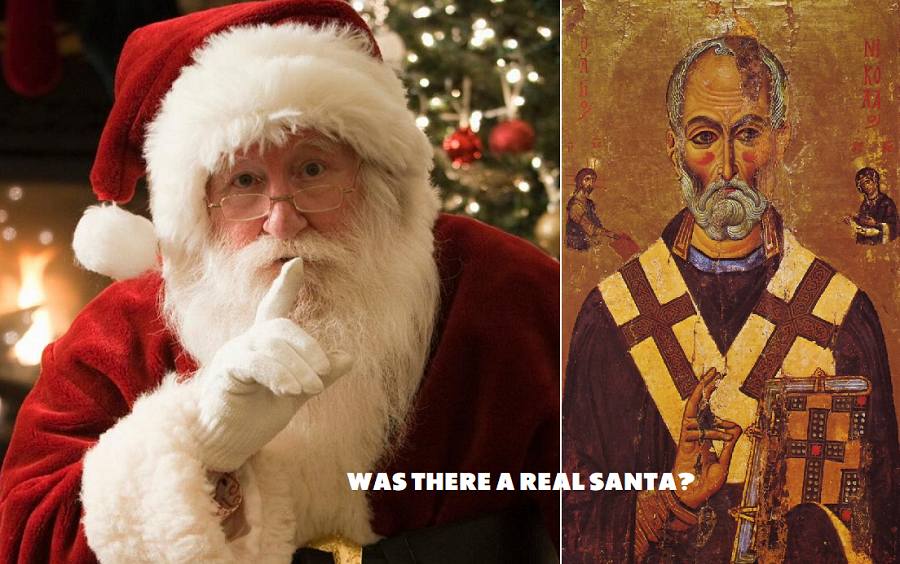Christians claim Santa Claus of Christmas myths is none other than a historical Christian Saint named Nicholas. This thread gives us a glimpse of the real man behind Santa Claus. It shows us how his character was drastically recreated by American commercials.
Today, Santa is everywhere. He is on Stickers. Cakes. You name it. He is shown as a warm, happy character with rosy cheeks twinkling eyes, and laughter lines who sends gifts to Children. This is a modern creation. Here is how real Santa Claus was depicted in historical paintings.
The “real Santa Claus” had nothing to do with today’s Santa Claus that is largely a modern commercial creation. The real Santa was a hot beaded, abusive, threatening & intolerant zealot who reveled in breaking the temples of Non-Christians & physically attacking his opponents.
One of the earliest references to “real Santa Claus” comes from an early, almost contemporary, account named Stratelatis written around c.400. This account and its story have also been corroborated by the high praise of Saint Proclus in his Encomium on Saint Nicholas (c.440 CE).
In these earliest accounts, “Santa Claus” comes in the defense of some prisoners. He threatens emperor Constantine and warns “Constantine, free the prisoners. If not, I will stir up a revolt against you, and hand over your dead body and your entrails to the wild beasts for food”
He also threatens a local governor named Ablabius: “Ablabius, free those three men. If not, you will fall ill and end as food for worms, and your whole family will perish evilly”. This image of Santa Claus issuing dεath threats is hardly compatible with his image today.
According to Christian sources., “Santa Claus” was an attendee of the Council of Nicaea convened by Emperor Constantine. In this council, he slaps a fellow Christian pastor named Arius who had opposed Trinitarian doctrine. For this physical assault, he was briefly imprisoned.
This deed has been alluded to by his early Hagiographers like Andrew of Crete (8th century) and Michael the Archimandrite (9th century). The real Santa Claus belonged to Myra (today’s Turkey). Myra housed a great temple to Goddess Artemis. It rivaled the temple of Artemis at Ephesus, one of the wonders of the ancient world. Santa Claus saw every Non-Christian God as a demon. He waged a crusade against temples.
Just about this time, Constantine became the first-ever Christian emperor in History. Making full use of the opportunity, Santa Claus broke the temple of Artemis with his own hands. A Christian painting depicts St. Nicholas/ Santa Claus breaking the idol of Goddess Artemis.
According to Christian sources, hundreds of Non-Christian temples were broken down by Saint Nicholas/ Santa Claus. Andrew of Crete(8th century) praises Santa Claus as an architect. “For breaking down idols and building Churches in their place”.
At this point, one must pause to ask. Where is the Santa Claus of Children? Where is the gift giver of Children? Where is the Christmas? Where is the snow? Where are the sleigh and reindeer? Where is the Santa cap? Where are the elves? His current image is a modern recreation!
Who reshaped the image of Santa? On its official website, Coca-Cola claims the credit for reshaping Santa Claus through its 1931 commercial. Although many attempts were made in the 19th century itself, this advertisement played a major role. Link - https://www.coca-colacompany.com/faqs/did-coca-cola-invent-santa
Even today, one can find the ruins of the great temple of Artemis lying scattered inside the original Church of Saint Nicholas/ Santa Claus located in his hometown in Myra(Turkey).
The image of Santa Claus began to be recreated in the 19th century even before the Coca-Cola advertisement. In the age of reform (c. 1850), Santa began taking his modern form. In this painting, he dips children in black ink. He starts to appear like modern Santa Claus.
But it is the 1931 Coca-Cola commercial that features the big jolly man that we know. It was Coca-Cola that popularized this modern image. Which depictions of Santa Claus in red/orange robe existed before the Coca-Cola ad, they were very rare. He was frequently shown in white costume which was appropriate for a bishop like him. The popularization of his red costume owed to the color of Coca-Cola.

































